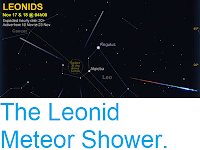The Geminid Meteor Shower is expected to peak at about 2.00 am on Friday 14
December this
year (2018) with potentially up to 120 meteors per hour being visible in
areas of the Northern Hemisphere with a clear sky. This year peak activity for the shower coincides with a waxing Crescent
Moon, with the New Moon having fallen on Friday 7 December and the Quarter Moon on Saturday 15 December, so viewing should
be fairly good. The meteors appear to radiate from a point in the
constellation of Gemini, hence their name.
The radiant point of the Gemenid Meteors
(i.e. the point from which the meteors radiate) at 10.00 pm on 13
December 2018. Astro Bob.
Oddly for a meteor shower, the Geminids do not appear to be related to a
comet, but instead are associated with an object called 3200 Phaethon,
which is classed as an Apollo Asteroid (an asteroid with an orbit that
crosses that of the Earth). 3200 Phaethon has a highly elliptical orbit,
which takes it in as close as 0.14 Au (14% of the distance between the
Earth and the Sun, more than twice as close as Mercury) and out as far
as 2.4 AU (2.4 times as far from the Sun as the Earth or 1.6 times as
far as Mars). 3200 Phaethon does not appear to produce any sort of halo
(a cloud of material produced by the evaporation of gas ice from the
surface of a comet, thought to be the source of most meteor showers);
rather it appears dark in colour an is classed as a B-type Carbonaceous
Asteroid, thought to have a surface covering of anhydrous silicates,
hydrated clay minerals, organic polymers, magnetite, and sulphides.
Image of 3200 Phaeton taken on 13 December 2017, four days before the asteroid made its closest approach to the Earth this century, reaching about 3 100 000 km from us. The photograph is a two minute exposure, leading the asteroid, which was moving to appear as a line in the image. Two Gemenid Meteors crossed the field of vision during this time, forming longer, fainter lines. Mikiya Sato/Nippon Meteor Society/Astronomy Picture of the Day/NASA.
Asteroid 3200 Phaethon is a 5 km body with a highly eccentric orbit
similar to that of a comet, which takes it closer to the Sun than any
other named Asteroid. It appears to be the parent body of the Geminid
Meteors, which share essentially the same orbit as it, as well as a
group of larger bodies known as the Phaethon-Geminid Complex. Such
meteor showers typically form from the tail of a comet; as the comet
approaches its perihelion (the closest point in its orbit to the Sun),
ice at the surface sublimates away (turns directly from a solid to a gas
- liquids do not form in a vacuum), releasing particles of silica
trapped in the ice, which continue to follow essentially the same path
as the comet, creating a meteor shower every time the Earth passes
through this stream. However, 3200 Phaethon, which has a 1.43 year
orbital period in which it reaches 0.14 AU from the Sun (14% of the
distance between the Earth and the Sun, or less than half the distance
at which Mercury orbits) is thought to regularly suffer surface
temperatures in excess of 1000K, making it highly unlikely that it has
ice on its surface, which calls its potential role as the parent body to
the Geminid Meteors into question. 3200 Phaethon is classed as an
Apollo Group Asteroid (an asteroid that is on average further from the
Sun than the Earth, but which does get closer). As an asteroid probably larger than 150 m in diameter
that occasionally comes within 0.05 AU of the Earth, it is also
classified as a Potentially Hazardous Asteroid.
The orbit and current position of 3200 Phaethon. The Sky Live 3D Solar System Simulator.
In a paper published on the arXiv online database at Cornell University Library on 17 June 2013, David Jewitt of the Department of Earth and Space Sciences and Department of Physics and Astronomy at the University of California Los Angeles, Jing Li of the Department of Earth and Space Sciences at the University of California Los Angeles, and Jessica Agarwal of the Max Planck Institute for Solar System Research, describe the results of a study of 3200 Phaeton using the NASA STEREO Spacecraft.
Jewitt et al. observed two successive perihelions of 3200
Phaeton, in June 2009 and May 2012. On both occasions they were able to
observe a faint comet-like dust tail emerging from the body, even though
it was apparently reaching temperatures that would rapidly destroy an
icy comet. This tail grew rapidly, reaching a length of over 250 000 km
within a day of first appearing, and appeared to represent material
being lost from the parent body at a rate of about 3 kg per second.
Composite images of 3200 Phaethon in 2009 (top row) and 2012 (bottom row) compared with the projected sun- comet line (white). The Sun is to the upper right in each panel. Insets are 49000 square and show eld stars near to Phaethon to demonstrate the point spread function of the data. Each panel has North to the top, East to the left and shows the median of 30 images taken over a 1 day period. Jewitt et al. (2013).
Jewitt et al. suggest that at it's perihelion 3200 Phaethon is
being heated to such a degree that hydrated minerals at its surface
could be thermally fractured and desiccated, leading to the ejection of
dust particles.
See also...
Follow Sciency Thoughts on Facebook.











